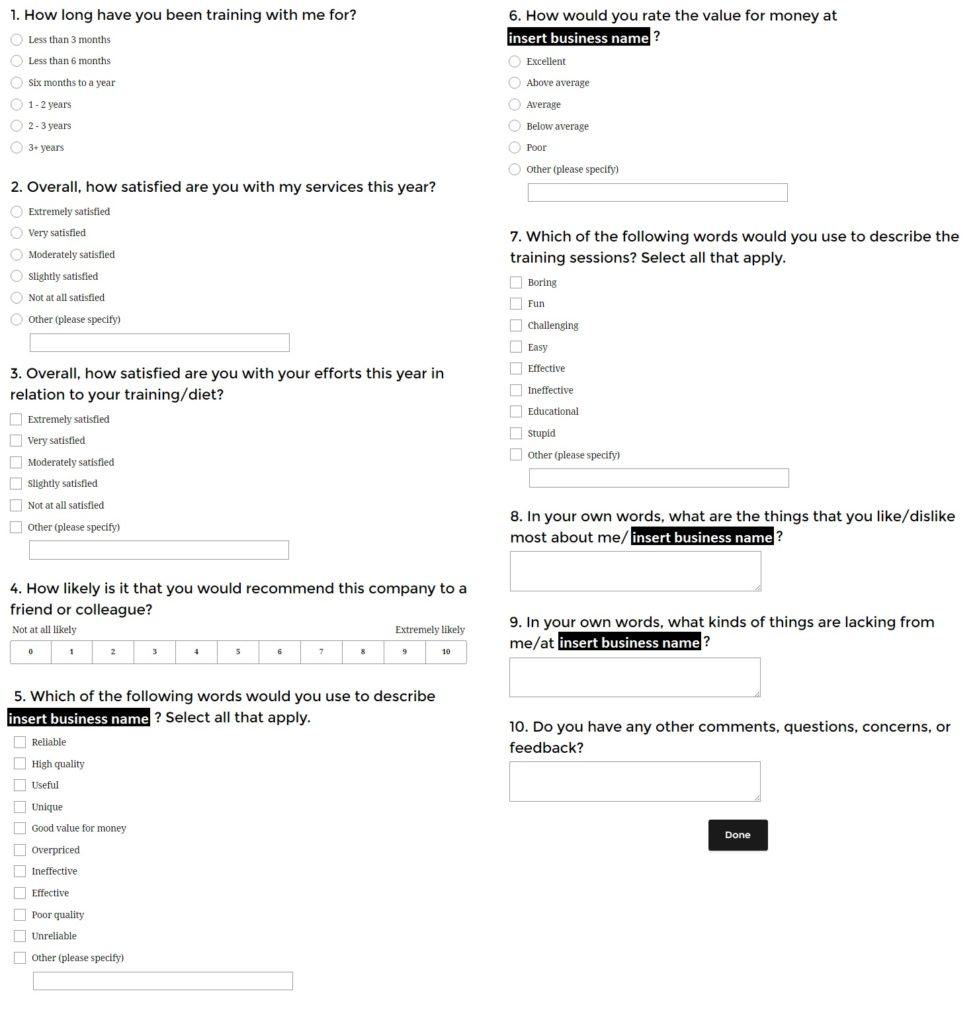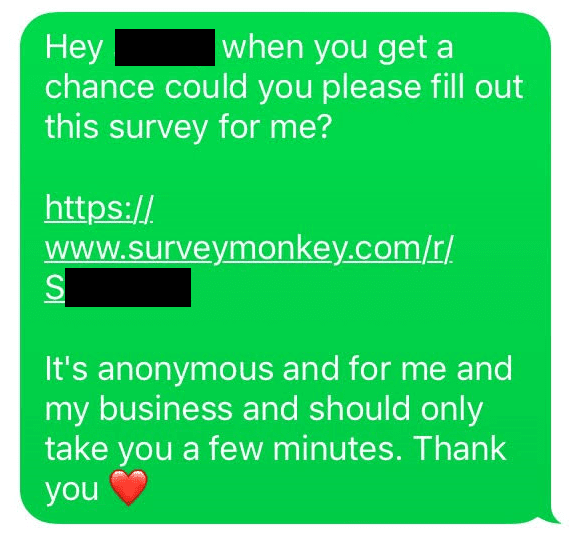Whether you’re an online personal trainer or training clients at a gym, there's no denying the importance for continuing to hone mastery in your craft. You learn and keep up with the latest science and techniques to help your clients achieve what they pay you for, sure, but just reading more training and more coaching material sometimes isn’t enough. And if you fall into this trap, you may be ignoring one of the most important parts of your personal training service: what your clients actually want and say about you.
In other words, what is your client feedback and general satisfaction with your coaching and services like? In a fitness business, this is incredibly important.
Most trainers remember to reflect and assess at the beginning of a new calendar year, but I urge you to do this as often as you can. Regularly reflecting and assessing yourself and your business goes a long way. When you analyze these key areas, you can find weak points and gaps in your understanding and methods, and can quickly take action to improve upon them.
One of the simplest ways to find these is to ask your clients for feedback.
Asking for feedback can be difficult at first
As you’ve probably noticed in the past, just straight-up asking your client how you’re doing face-to-face can sometime be either ineffective or really scary.
That latter point has to do with our ego, and with an industry that can be very ego-driven, the fear of failure is widespread as it manifests itself within many areas of the business.
Can’t get a client in the door? You “fail” at sales and marketing. Can’t get a client to do what you say? You “fail” at motivating and working with your client. These are perhaps extreme examples, but hopefully you see what I mean.
As a result of all this, you might not want to know what your clients actually say about you, in fear of risking a bruised ego. But if we are not aware of how we are perceived by our clients, potential clients, friends, family, or even that random guy on the street, then how can we hope to better ourselves just as we constantly preach that our clients should do?
Or, perhaps the reason you’re afraid to ask for feedback is that you’re complacent or just bored--two commonalities in those who’ve become used to a routine. This might be okay if you want to be “fine", but if you want to move from “fine” to “great”, you need to wake up and seek out what you can do to improve yourself and your business.
READ ALSO: How to Market Yourself as a Personal Trainer
5 steps to simply and effectively ask for client feedback
While there are many ways to solicit feedback, one of my favorite ways is to use an online survey, like Survey Monkey. They’re reliable and reputable and offer free and paid plans. For our purposes, the free version fits our needs just fine.
One of the perks of using an online survey is that you can make them entirely anonymous. You may find that sometimes asking people outright might cause them to choke on their words, get things muddled, totally forget to mention important details, or simply lie to avoid hurting your feelings.

The opportunity for anonymity in an online survey allows your clients to be more open and honest with you, and ideally, provide you with more constructive criticism. The following is what I have found to be the best ways of going about putting together the perfect survey.
Step 1. Ditch your ego
Don’t be afraid to find out certain things about yourself from the client’s perspective. It’s scary at first, but it’s always good to put yourself out there and open yourself up to criticism. It's not about coddling your ego. It's about growing your business.
Good, honest feedback helps you grow.
Step 2. Figure out what you want to know
Really think about your questions, but be sure to angle them so that they provide valuable insight to your services and business, not just stroke your ego. Questions like, “Do you think I’m awesome?” has no place in a feedback survey.
You want to ensure that your questions allow for high-quality answers. Spend a day or two just jotting things down you want to improve on, then take these ideas and break them down into smaller, simple questions. Think about things like your communication or coaching--is it clear and easy to understand? Or maybe your programs themselves--are your programs easy to follow? What about your relationship with your clients? Do your clients trust you to solve their problems?
Remember, you want your survey to be valuable to you, but at the same time, not bog your client down with complicated questions. Plan to have a mix of multiple choice, ranking scales, and open-ended questions.
Step 3. Compose your questions thoughtfully
Believe it or not, it’s much harder to write a good question that’s fair and doesn’t bias your client’s answer--whether you intend to or not--than you think. The first thing is to use simple, direct language, but to be as specific as possible. Here’s an example of what I mean:
“Do you exercise regularly?”
Versus
“How many days per week do you exercise (on average)?”
The former is simple, yes, but gives you no additional helpful information, whereas the latter is more objective and is actually insightful. Avoid cluttering your questions with multiple ideas; focus on one thing per question.
Also, avoid “leading questions”, which subtly corners someone to thinking only about the options you provided. An example is something like, “Do you think it’s better to measure your progress once per week or once per month?”
Overall, you’re better off asking more open-ended questions like “What do you find most helpful about training with me?”, “What do you wish I could help you solve?”, or “What’s one thing you’ve always wanted to tell me about my training but haven’t yet?”
These are more revealing questions, and since the survey can be anonymous, your clients are less likely to have guarded responses.
Step 4. Introduce the survey to your clients
Make sure that you introduce the survey by letting your clients know why surveying them is both important to you and them. A lot of people tend to disregard these types of things because they’re busy or feel like it’s not that important. Let your clients know that you want to improve their experience and results and that their feedback can help you do that. Additionally, give them a heads up about your survey by saying something at the end of your session, for example. You can say:
“Hey , we’ve been training together for some time now and I really want to make sure that what I’m doing my best to help you. Will you help me help you by filling out a quick online survey? I’ll send it to you this afternoon.”
They’ll usually say yes, and this simple “commitment” helps them remember to fill out your survey and give constructive feedback. If you’re training clients online, you can send an email with a subject line, like “Help me help you…” Remember to include a sort of deadline, too.
Here’s what a recent survey of mine looked like:

Here is the text that I sent out also to get people to want to click the link:
Step 5. Collect responses and organize them into information you can act on
Give it some time (a couple of weeks should be fine) to get a good number of responses and track how many you send out. Don’t freak out if you don’t hear back from people immediately. If people get a text with a link to a survey while they’re at work, for example, you can most likely count on them disregarding and forgetting about it by the end of their day. So gently send a reminder after a few days. Sunday afternoon or even Saturday mornings are a good time to send texts or emails out.
If after the first couple of times your client doesn’t respond, don’t continue to hound them. Not everyone will fill it out, and that’s okay. The ones who do truly have something to say and care about your service.
Go into these responses with an open mind and read what your clients have to say about you. You may be shocked by how many nice things you read, but for the negative remarks that do show up, write them down. Chances are, you might find some similarities or patterns, so be sure to note those down to the very detail of how they talk about their problems or issues--whether they’re related to you or not.
Now you have crucial information at your fingertips on how to improve both your business and yourself. And that’s important. Remember, you are after growth, so any feedback from the people that use your services and interact with you is good feedback.










